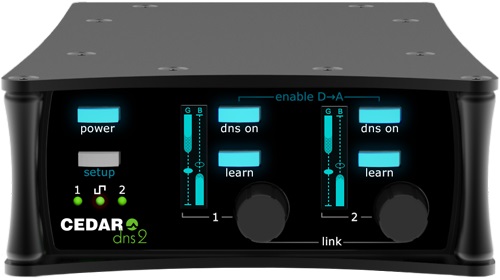CEDAR's dialogue noise suppression (DNS) technology eliminates traffic noise, air conditioning, wind, rain, babble and general background noise from audio signals. It will also help to compensate for unfavourable acoustic conditions and poor microphone placement, and will even suppress excessive reverberation.
The 2-channel DNS 2 is the first DNS designed specifically for portability and extreme simplicity of use. It hosts a new DNS algorithm that requires nothing more than switching on the Learn function that identifies and adapts to the background noise, and then dialing in the amount of noise attenuation required. Retaining the near-zero latency of all its predecessors, it's suitable for use in all situations - location recording, live-to-air broadcasting, live sound in venues such as theatres, concert halls, conferences venues, and places of worship, as well as studio work and post.
What's more, despite being so small and light that you can slip it inside your pocket or equipment bag, the DNS 2 offers analogue line and microphone inputs (the latter with optional 48V phantom powering), an AES3/AES11 digital input, and both analogue and digital outputs. This increases its flexibility even further, and its 12V power input means that you can use it in the middle of a field as easily as in the studio or the edit suite.
Designed for use anywhere that you might need it, the DNS 2 offers:
- the latest adaptive noise suppression technology
- the fastest and most intiutive interface ever designed for DNS
- analogue and digital inputs and outputs
- 12V operation and camera mounting points
The DNS 2 offers virtually zero latency so it can be used live without loss of lip-sync. Yet it still eliminates traffic noise, air conditioning, wind, rain, babble and general background noise, compensates for unfavourable acoustics and poor microphone placement, and suppresses excessive reverberation.
It can even output simultaneously the raw and processed versions of a single signal, which makes it ideal for use on location as well as in the studio and in all live situations; not just live-to-air broadcasting, but also for live sound in venues such as theatres, concert halls, conferences venues, and places of worship.

